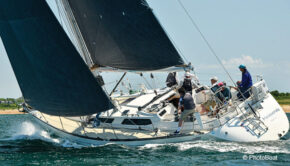Morphing into an Adult Sailor
Published on September 23rd, 2013
While youth sailing participation has never been greater in North America, much of that growth is due to youth-centric events. Pairing same-age sailors in non-technical boats has proven popular, but transitioning from the “youth bubble” to open sailing has been the challenge.
Griffin Rolander, who won the 2013 Inland Lake Yachting Association (ILYA) Club 420 Championship in Delavan, WI on June 23, describes how he has grown from a youth sailor to a life sailor…
Two summers ago I finished my last X-boat regatta (ILYA junior trainer up to 16 years of age), and was officially thrown into the intangible bubble where youth sailors morph into adult sailors. I had decisions that needed to be made, and plans that had to be executed. Of course I wanted to continue sailing, but how? What was my next step?
With plans to sail in college, but without direction on exactly how to accomplish that goal, I decided to train in the Club 420, the typical college sailing dinghy. I started a sailing team at my high school, sailed part of the East Coast 420 summer circuit, and managed to successfully navigate the college planning process.
I committed to Tufts University and was excited to test my skills against some of the best sailors in the nation. I knew I needed to come into Boston in the best sailing condition of my life, but I was not interested in continuing in the Club 420 regattas.
This past spring, with high school graduation looming, a grant application to charter a Melges 17 became available through my sailing school. I had been crewing on E-scows and A-Scows off and on for a few years now, and had already grasped the concept of the overwhelming speed and power scows had in heavy air. The Melges 17 provided an easy entrance into the scow world and performance sailing.
Similarly sized to the Club 420 and X-boat, the Melges 17 has a much more buoyant and lightweight hull build, combined with more sail area, including an asymmetrical spinnaker. Not only does this provide a much faster boat, but also participating in the class itself requires responsibility.
The sailors, who range from pre-teens to adults, largely run the class and the lack of coaching present in the youth boats forces transitioning sailors to become responsible for themselves. I had to ask questions to the elder sailors about the boat, research the best rigging techniques, and take notes of what worked well.
Additionally, the boat itself is incredibly easy to travel, which helps build confidence in traveling on your own. On the water, the competition is stiff and the class is only increasing in popularity, as it requires just two sailors, is more affordable, and is every bit as fast as the other scows.
I was granted the sailing school charter and was ecstatic for the season to start. This experience offered no downsides. It would help me prepare for college with the required responsibilities of training and traveling on my own, and help me prepare for college sailing through the experience of skipping a performance sailboat.
The first race of the summer started in the only way I could have imagined: the breeze was on. We arrived at the lake the night before, and foolishly, I rigged the boat for the very first time just an hour before the first club race started. Regardless, I had a beautiful start followed by a great first leg and found myself in second place at the top mark. We had a rough set, took more time than I would have liked getting on a plane, but we still sat in second.
I looked over my shoulder and decided I needed to gybe. I was a little unsteady, as I only had the opportunity to practice one gybe and the wind had picked up since that point. I started slowly and things were looking decent. My crew was in the process of switching the spinnaker sheets as I moved to the other side of the boat. I ducked as the boom came over, but slowly found myself losing my footing. I fell and turned the tiller sharply causing us to head up. The spinnaker filled and not long after, both my crew and I were in the water.
Regardless of tipping on my first downwind, the race was awesome. The speed of the boat really captured my attention, and I knew if I wanted to perform better in the class I needed to be able to react quicker and smarter on the water. With each week of racing, I finished in a better position, becoming satisfied with the improvements I was making. Additionally, I could that feel my reactions about boat on boat tactics were becoming sharper and were profitable on the water. As the summer was wrapping up, the Melges 17 Inlands were about to take place and I felt well prepared to race against some of the best Melges 17 sailors in the country.
The regatta was forecasted to be a windy event, and the competition was stiff. I scanned through the registration list and grinned when I realized not all of the competition was made up of parents. I was racing against many of the same kids I sailed X boats against, as well as sailors who I currently coach alongside with at the youth events. I decided I wanted to place in the top five. I knew that if I sailed smart and focused, my goal was attainable. The first day flew by and I was sixth in the standings, only two points out of fifth. During the last race of the regatta, however, I had an experience that will not be forgotten.
Around the last windward mark of the race, my crew and I finally had the perfect set, immediately filling the spinnaker and getting the boat up on a plane. I hiked out hard with my body angled significantly far back in the boat, and we started skipping down the water on starboard gybe in twenty knots. I glanced behind me and noticed that my best friend, who I had been sailing against since X boats and Optimists, was on my tail. It always felt good to be ahead of a buddy.
While I sat in 5th place, I took a moment to reminisce about how much faster this 17-foot scow was than the similarly sized Club 420 I had been training in, and how I’ve spent the last ten years of my life sailing a boat with a single dagger board. As it sped across the water, I thought about how a slight turn of the rudder caused such a significant change in the boat’s direction. A moment later I lost myself in the ferocious spray of water formulated from an uneven powerboat wave. I shook my head, water dispersing to the edge of my sunglass lenses, and was already back up to full speed.
I glanced under the boom and, eyes widening, I realized I had sailed right past the port lay line. I threw a painstakingly jerky gybe in to save some distance, but had a flashback of my first Melges 17 race. I slowed down the gybe and prevented a capsize, but in turn lost more distance to windward. Once on the new board, all I could say as I heated the boat up to point at the leeward gate was, “We might go over.”
The boat sped up, traveling faster than the wind, and I felt a sudden rush of euphoria. The foot of the spinnaker was on the water and my main was eased, but we kept accelerating, heeling up past my point of comfort. Miraculously, our hard work paid off, and we made it to the mark unscathed – minus a few new calluses formed on my crew’s hands hidden beneath his gloves.
The amount of joy and relief I felt after we doused the spinnaker and turned upwind around the marks matches no other sailing experience I’ve had. Not only was a memory engraved, but also my goal was achieved, as I finished the regatta in fifth.
After only one summer of sailing the Melges 17, I know that I want to continue my quest. The boat is humbling at first, being a class that takes practice to be successful in, but the practice prepared me for college sailing. The Melges 17 brings a whole new aspect of sailing to the table: one containing high speeds, quick movements, and more responsibility.
I came out of the summer feeling much more prepared for college sailing and that extra bit of confidence gained will bode well for my sailing future. I highly recommend considering sailing in the Melges 17 class.
Editor’s note: While the Melges 17 may not be active in each area, odds are another one design class is, and encouraging a youth sailor to participate may be all that is needed to help them “morph into adult sailors”.
Source: ILYA Scowlines, a publication of the Inland Lake Yachting Association.








 We’ll keep your information safe.
We’ll keep your information safe.